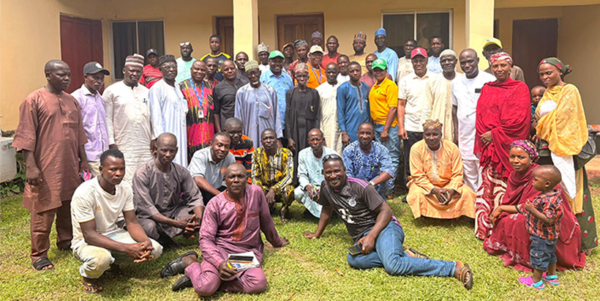International Institute of Tropical Agriculture Trains Extension… – Grain Journal

Report on Post-Harvest Management and Aflatoxin Control Training Initiative
Introduction: A Collaborative Effort for Sustainable Food Systems
A strategic training workshop was conducted on October 9-10, 2025, in Lafia, Nasarawa state, to address critical challenges in Nigeria’s food value chain. This initiative, a collaboration between IITA-CGIAR, the TAAT Clearinghouse, and the SASAKAWA Africa Association, aimed to build capacity among extension agents and lead corn farmers. The training focused on improved post-harvest handling, grain quality preservation, and aflatoxin management, directly contributing to the achievement of several Sustainable Development Goals (SDGs), particularly SDG 2 (Zero Hunger) and SDG 12 (Responsible Consumption and Production).
Workshop Objectives and Key Issues Addressed
The primary objective was to mitigate the significant post-harvest losses that undermine food security and economic stability in Sub-Saharan Africa. The workshop brought together researchers, field officers, and farmers to create a unified approach to grain management. Key issues highlighted include:
- High Rate of Post-Harvest Losses: It was reported that between 20% and 30% of grain is lost post-harvest in the region, a major impediment to achieving food security as outlined in SDG 2.
- Aflatoxin Contamination: The prevalence of aflatoxins in corn poses a severe risk to public health, directly conflicting with SDG 3 (Good Health and Well-being) by compromising food safety.
- Knowledge Gaps: A lack of awareness regarding modern storage and handling techniques among farmers contributes to quality degradation and economic loss, affecting progress towards SDG 1 (No Poverty).
Technical Interventions and Capacity Building
Specialists from IITA provided comprehensive training on evidence-based technologies and practices designed to safeguard grain from harvest to consumption. These interventions are crucial for building resilient agricultural systems in line with the SDGs.
- Aflasafe Biocontrol: Participants were introduced to Aflasafe, an IITA-developed biocontrol product that effectively reduces aflatoxin contamination in corn, thereby ensuring safer food for communities and supporting SDG 3.
- Hermetic Storage Solutions: Demonstrations included the use of hermetic storage technologies like the Cocoon storage system, which prevent pest infestation and moisture damage without chemical pesticides, promoting sustainable practices under SDG 12.
- Improved Handling Practices: Emphasis was placed on the entire post-harvest process, including timely harvesting, proper drying, and sorting techniques to maintain nutritional and market value, which enhances farmer income and contributes to SDG 2.3 (doubling agricultural productivity and incomes of small-scale food producers).
- Natural Pest Control: The application of Diatomaceous Earth was demonstrated as an effective and environmentally safe method for pest control in stored grains.
Alignment with Sustainable Development Goals
The workshop’s agenda and outcomes are fundamentally aligned with the global 2030 Agenda for Sustainable Development. The initiative’s contributions include:
- SDG 2 (Zero Hunger): By drastically reducing food losses, the training directly enhances food availability and access to nutritious food. Empowering farmers with these skills strengthens local food systems.
- SDG 3 (Good Health and Well-being): The focus on aflatoxin management is a direct intervention to reduce illnesses and deaths from food contamination (Target 3.9).
- SDG 12 (Responsible Consumption and Production): The initiative squarely addresses Target 12.3, which aims to halve food losses along production and supply chains by 2030.
- SDG 17 (Partnerships for the Goals): The collaboration between international research institutions (IITA-CGIAR), technology clearinghouses (TAAT), and non-governmental organizations (SASAKAWA) exemplifies the multi-stakeholder partnerships required to achieve the SDGs.
Conclusion and Future Directives
The training was positively received by participants, who committed to disseminating the learned techniques within their respective communities. The workshop concluded with a call for the continuous sensitization of farmers and the widespread adoption of innovative post-harvest technologies. Such efforts are essential to protect Nigeria’s corn sector, ensure regional food safety, and make substantive progress toward achieving the Sustainable Development Goals.
1. Which SDGs are addressed or connected to the issues highlighted in the article?
The article highlights several issues that directly connect to the following Sustainable Development Goals (SDGs):
-
SDG 2: Zero Hunger
This goal is central to the article. The entire initiative described—training farmers and extension agents on managing post-harvest losses, improving grain quality, and controlling aflatoxin—is aimed at increasing the availability of safe and nutritious food. By addressing the “significant bottleneck in Africa’s food value chain” where “much is lost between the farm and the table,” the project directly contributes to ending hunger and ensuring food security.
-
SDG 12: Responsible Consumption and Production
This goal is addressed through the article’s focus on reducing food losses. The training on “improved post-harvest handling” and the introduction of technologies like “hermetic storage” are practical steps to ensure more efficient production and supply chains, which is a key aspect of sustainable consumption and production patterns.
-
SDG 17: Partnerships for the Goals
The article explicitly demonstrates the importance of partnerships. The training workshop was a collaborative effort involving multiple organizations: “IITA-CGIAR, and the TAAT Clearinghouse in collaboration with SASAKAWA Africa Association.” This multi-stakeholder approach, bringing together “field officers, researchers, farmers, and development partners,” is a core principle of SDG 17, which emphasizes that global goals can only be achieved through strong partnerships.
2. What specific targets under those SDGs can be identified based on the article’s content?
Based on the article’s content, the following specific SDG targets can be identified:
-
Target 2.1: End hunger and ensure access to safe and nutritious food
The article’s focus on “aflatoxin management” and creating “safe food systems” directly aligns with this target. Aflatoxin is a toxic contaminant that makes food unsafe for consumption. By training farmers to use biocontrol products like “Aflasafe,” the initiative aims to ensure that the available corn is safe and maintains its “nutritional value,” contributing to year-round access to safe food.
-
Target 2.4: Ensure sustainable food production systems and implement resilient agricultural practices
The training on “adequate storage and grain quality management” promotes resilient agricultural practices. Technologies and methods discussed, such as “hermetic storage,” “safe drying, sorting,” and the use of “Diatomaceous Earth for pest control,” are designed to make the post-harvest stage of food production more sustainable and less prone to losses, thereby strengthening the food production system.
-
Target 12.3: Halve per capita global food waste and reduce food losses
This is one of the most directly relevant targets. The article’s primary goal is to “combat post-harvest losses.” It even quantifies the problem, stating that losses in Sub-Saharan Africa are “estimated to be between 20% and 30%.” The entire workshop is an intervention aimed at reducing these food losses along the production and supply chain.
-
Target 17.16: Enhance the Global Partnership for Sustainable Development
The article is a clear example of this target in action. The collaboration between international research institutions (IITA-CGIAR), clearinghouses (TAAT), and non-governmental organizations (SASAKAWA Africa Association) to “mobilize and share knowledge, expertise, technology” (such as Aflasafe and hermetic storage) with local farmers and extension agents exemplifies a multi-stakeholder partnership for sustainable development.
3. Are there any indicators mentioned or implied in the article that can be used to measure progress towards the identified targets?
Yes, the article mentions or implies several indicators that can be used to measure progress:
-
Indicator for Target 12.3: (Official Indicator 12.3.1.a) Food loss percentage
The article explicitly provides a baseline metric for this indicator by stating that post-harvest losses in Sub-Saharan Africa are “estimated to be between 20% and 30%.” Progress towards Target 12.3 could be measured by tracking the reduction of this percentage in communities where the trained agents and farmers implement the new techniques.
-
Implied Indicator for Target 2.1: Prevalence of aflatoxin contamination in corn
While not a formal SDG indicator, the article’s emphasis on “aflatoxin management” and the introduction of “Aflasafe” implies that a key measure of success would be the reduction in the levels of aflatoxin found in stored corn. This would serve as a direct measure of improved food safety.
-
Implied Indicator for Targets 2.4 and 17.16: Number of farmers and extension agents trained and adopting new technologies
The article describes a training workshop for “extension agents and corn lead farmers.” An implied indicator for measuring the success of this partnership and the implementation of resilient practices is the number of individuals trained and, subsequently, the rate of adoption of the “innovative post-harvest technologies” (like hermetic storage and Aflasafe) by the wider farming community. The quote from Muhammad Musa Arume, who plans to “pass on [the techniques] to farmers in my community,” points to this dissemination and adoption process.
4. Table of SDGs, Targets, and Indicators
| SDGs | Targets | Indicators |
|---|---|---|
| SDG 2: Zero Hunger |
|
|
| SDG 12: Responsible Consumption and Production |
|
|
| SDG 17: Partnerships for the Goals |
|
|
Source: grainjournal.com
What is Your Reaction?
 Like
0
Like
0
 Dislike
0
Dislike
0
 Love
0
Love
0
 Funny
0
Funny
0
 Angry
0
Angry
0
 Sad
0
Sad
0
 Wow
0
Wow
0


















































.jpg.webp?itok=0ZsAnae9#)





/environment-climate-change-and-health-(ech)/water-sanitation-hygiene-and-health-(wsh)/landfill-tuvalu-36092.tmb-1200v.jpg?sfvrsn=5c21fe40_1#)



















